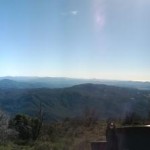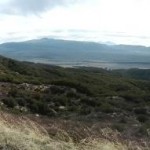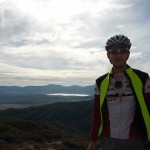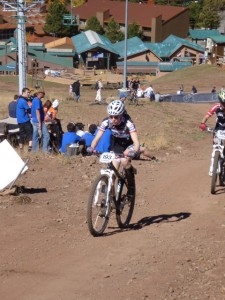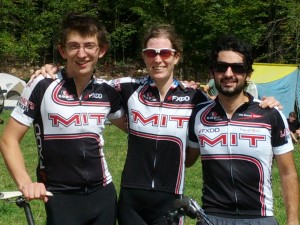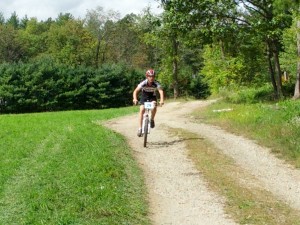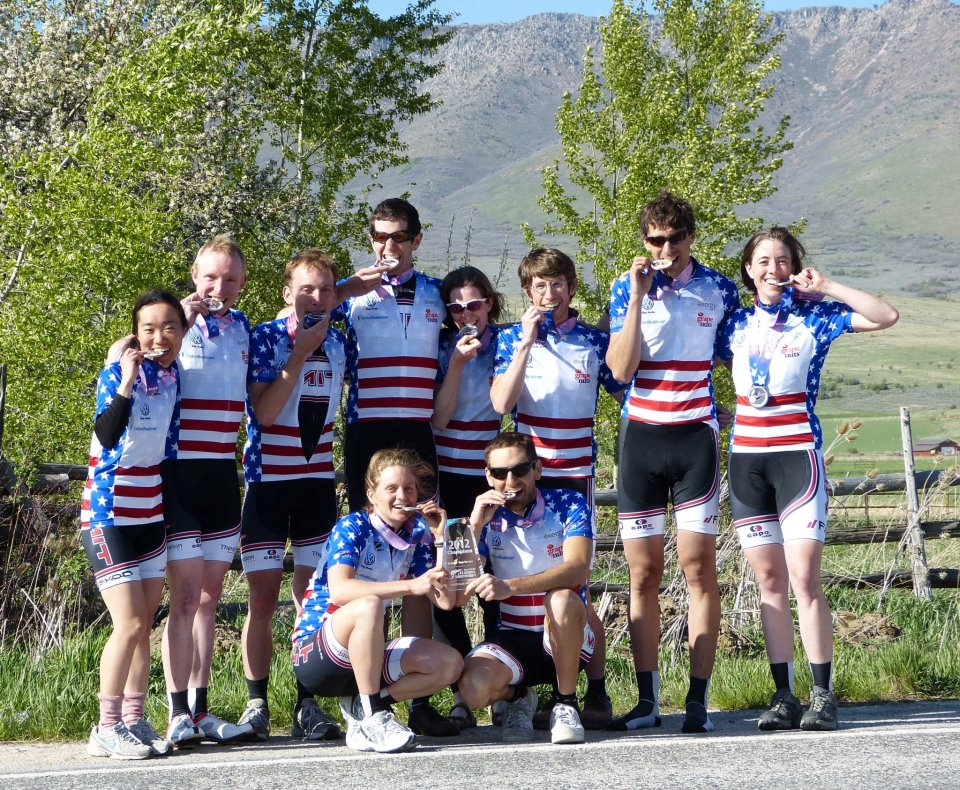I didn’t make it on to the team camp this year as it coincided with some other travel obligations, but luckily I got to fit in some extra days riding in the San Diego county area between Christmas and New Year’s, as I had a conference in San Diego on 3rd Jan. We (Kenny and I) stayed at a higher elevation: 4,200′ in Warner Springs, rather than in Borrego Springs at 800′. I can certainly vouch for the other accounts that it is a lot colder higher up. It actually snowed while we were there! We took our cyclocross bikes and did several high resistance rides through the snow on the dirt/restricted access roads through the Palomar Mountains, Cleveland National Forest, and on one day we had some great views across from these mountains all the way to the Pacific Ocean and San Diego. Here are a couple of photos from the trip (the first two images are panoramics that are a bit more interesting if you click on the them to enlarge them):
Tag Archives: laura ralston
to MTB, or not to MTB – that is the question
At the moment, I am filled with a bittersweet sensation: sweet because I found an awesome new form of fun on two wheels, and bitter because I only really got into it in my last year at MIT. Honestly, MTB-ing is so much fun and I would urge all the other team members to give it a try at some point. It’s a great contrast to riding on the roads since you get to get away from all those grumpy Boston car drivers and see some of the great trails New England has to offer, and it is fun to challenge your bike handling skills on different terrain. I certainly feel like it’s made me a much more competent rider – if someone goes down in front of me in the race, or I suddenly need to ride off-road to avoid a crash, I don’t feel like I’m going to freak out and slam on my brakes (which I probably would have done a couple of years ago), and half the challenge of staying safe in road races is not just about whether you avoid crashing out yourself but how you respond to things happening around you.
So if you take away once piece of wisdom from this blog post – try MTB-ing! It’s now really easy to try even if you don’t have your own bike, since MITOC rents out bikes for as little as $15 a day: http://mit.edu/~mitoc/www/




MTB Nats
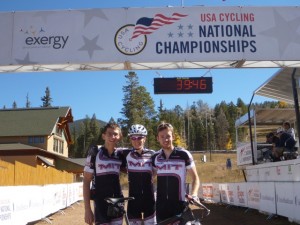
For the first time since Katie Harris’ dominant performance in 2008, MIT Cycling sent three riders to Angel Fire, New Mexico for the 2012 Collegiate Mountain Bike Nationals. Although MIT hasn’t been as dominant on the dirt as it has been on the roads for the past few years, these three riders sought to put MIT back on the national mountain bike map.
Since the beginning of the 2012 season, sending a team to Nationals was one my personal goals as captain. It was really awesome to feel excitement for the race building throughout the season, and especially watch my teammates share in this excitement in preparing. Laura Ralston, long a force-to-be-reckoned-with on the road, competed in her first-ever collegiate mountain bike race season and was competitive enough to secure podium spots and easily secure a spot at Nationals. Luke Plummer, dedicated from the beginning, struggled through persistent mechanicals to upgrade to the A category, but after a first-place short track finish managed to qualify by the skin of his teeth at the last race of the season. With a final team cemented, Luke, Laura and I packed our bags and headed out West.
After arriving in Denver and watching the plains gradually rise into the Sangre de Cristo Mountains on our six-hour drive south we finally arrived in Angel Fire, NM. With not much but a ski area and a few small restaurants, the whole town of Angel Fire buzzed with anticipation as the horde of mountain bikers descended. After hurriedly building our bikes in the parking lot and checking into our room, we headed out to the course to get our pre-ride in. The course, with a start elevation of 8,500’, began immediately with a lung-popping 1000’ climb up the ski resort. Talk about a warm-up. It being a pre-ride, we took it really easy, but knew just how exquisitely painful it would be the following morning. After a technical singletrack section through a volcanic rock garden, the climb finally turned downward for the gloriously buff, bermed and curvy descent. As I floated down that flowy singletrack that first day and even lap after lap during the XC race, I found it impossible to wipe that perma-grin off my face.
Ok, maybe not impossible. On the starting gun the following morning, I could feel the thin, dusty, and dry mountain air searing my lungs as I fought to stay with the pack on the steep doubletrack that started the course. Narrowly avoiding a crash on the dusty off-camber first corner, I stuck with the bunch and made a few passes until it began to string out and settle down. On the second lap, Luke joined me, and we continued to catch a few riders off the back. As the DI leaders zipped by, we figured we’d also soon be lapped by the DII leaders. Considering how tough that climb was, this wouldn’t have been the most terrible thing – it would have meant only three, not four laps. As we crossed the line of our third lap, the race director urged us on – we hadn’t been lapped! Proud of this accomplishment, yet somewhat apprehending of the riding the climb once more we pushed on – only to hear the DII leader cross the line 100 meters behind us. We enjoyed our final lap (especially the descent), even considering crossing the finish at the same time Lemond-Hinault style. Laura put in a great performance in the DII women’s race. Building on her road experience, she powered up the climb time after time to put in a 7th place finish.
The following day’s short track proved no less trying. Each lap included eighty feet of climbing, which doesn’t sound like too much but proved extraordinarily painful every time. That, in combination with a fast but dusty descent and an off-camber gravelly turn made for an interesting but short race. Luke improved on his performance, placing 39th, as did Laura, who made 5th!
After such a great racing experience, we couldn’t resist the urge to go for a fun victory ride. Turns out we were but miles from the best mountain bike trail in New Mexico – the South Boundary Trail – which connects Angel Fire to Taos, NM. Generally, it’s done as a one-way, mostly downhill ride, but we didn’t have quite enough time to arrange for a shuttle. Instead, we drove our rented minivan 7 miles up a rough dirt road to intersect the trail at the Heaven on Earth section. After some confused navigation and interesting interactions with the locals, we finally found the trail and got riding. The Heaven on Earth absolutely lived up to its name: gradual, smooth downhill through groves of quaking aspen led us up a gentle climb to the top of Osha Peak with beautiful vistas of the surrounding mountains around every corner. After a snack and a nature-appreciation break, we barreled back down Osha Peak, the flowing turns through the aspen like a dream. Eventually, the sun setting, we arrived back at the car just in time to drive back to Denver for our flight the following morning.
Thanks to everybody at MIT Cycling for the opportunity to race at Nats! I’m excited for an even better performance next year.
See y’all out on the dirt soon!
-Ben Eck
My first collegiate MTB race
Last Saturday, I tried out my first MTB race and had so much fun! I splurged on a mountain bike last year, when I saw a deal on eBay, and played around on it a couple of times in the Fells last Spring, but after I kept falling off and bashing my knees, I decided to give it a break until the road season was over. Green Mountain was my last really important road race, over the Labor Day weekend, so I decided it was time to get down and dirty, and get the bike (+ recently purchased knee and shin guards) out of the closet and start riding it again.
I did a couple of rides in the Fells last week, attended the very helpful clinic by our new MTB coach Sara Bresnick, and tested myself at a local race (Wompatuck’s Landmine Classic) a week earlier, before deciding to show my face at collegiate race. The Wompatuck race had been quite a lot of fun, but I flatted, I was not really sure how to change a tube on a tubeless tire – luckily some very kind gentleman helped me – so that ended up being more of a ride than a race.
The collegiate XC race was an absolute blast. It was hosted at Holiday Brook Farm in Western Massachusetts and I loved the 4.5 mile loop. There was a lot of super smooth single track and the course was extremely undulating. I felt my advantage was pumping it up all the short steep climbs, while I simply tried to hold onto my nerve on all the downhills and ride as cleanly as possible. The race ended up coming down to a duel between me and another woman from UVM – I think I was a bit stronger on the climbing and I would sometimes manage to open up a gap, but she was so much more comfortable on all the descents and would make up ground in those sections. In the final lap I caught back up to her at the top of a 20 sec climb, and as we both tried to push out the last pedal stroke before cresting the hill, we somehow collided and I ended up a little worse off with twisted handlebars. I picked myself up and resigned myself to a solid second place, since I knew my skills with even straight handlebars wouldn’t match hers on the remaining descents, and safely completed the course, 25 seconds down on the winner, but 1 min 20 sec ahead of 3rd place!
For the remainder of the day, I enjoyed watching more gutsy riders tackle the dual slalom and I’ve attached some video of Ben and Lluis doing this!
Interview with the MIT National Champion Road Team
On 4-6th May the MIT cycling team sent 10 riders (Katie Quinn, Yuri Matsumoto, Chris Birch, Laura Ralston (myself), Adam Bry, Spencer Schaber, Zack Ulissi, Andrew Lysaght, Sebastien Gauthier and Joe Near) and one support staff (Nate Dixon, also club president) to Ogden, Utah to compete in the National Collegiate Road Championships, and I’m proud to say that they won the team omnium for division 2 schools. We also filled the podium in all the women’s events: Katie Quinn took 1st in the road race (RR), 2nd in the criterium (crit) and 1st in the team time trial (TTT), Laura Ralston took 1st in the crit and 1st in the TTT, Chris Birch got 1st in the TTT, 3rd in the crit and 4th in the RR, and Yuri Matsumoto got 1st in the TTT, 4th in the crit and 5th in the RR. And the men did pretty well too with 2nd in the TTT and several respectable (mid-teens to early 20s) finishes in their RR and crit.
To enable you to re-live some of our Nationals moments I asked the riders to respond to a couple of questions about their experiences at the event and as team leaders over this wondrous season!
Laura Ralston: Katie, how does it feel to have captained such a strong women’s team for the last 2 years? What are your secrets to success?
Katie Quinn: The MIT women’s cycling team had a fantastic record of success long before I joined the team! It’s been an honor and loads of fun to captain and race with and learn from a team of the women who encouraged me to race in the first place! I think the ultimate achievement in cycling is having a team race their heart out to execute a thoroughly planned race strategy. I think the MIT women’s team does this at almost every race we do. Sometimes it doesn’t pay off … but sometimes it does and that’s an incredibly fun experience!
LR: Individually you had a fantastic set of results at Nationals – what were your best moments?
KQ: Hmmm.. I want to use the same idea as above but I guess you won’t use both answers anyway so..(LR: typical Katie – being as humble as ever!!!) I think the ultimate achievement in cycling is having a team race their heart out to execute a thoroughly planned race strategy. The best moments of Nationals were points of each race where I realized that we’d done exactly that…Crossing the finish line of the TTT together, knowing that our skill and discipline had got us over the course as efficiently as we could. The few laps of the crit where Laura and I pulled away together off the front of the race, knowing that we were both fully committed to stayed in the lead, and that Yuri would be strong and skilled enough to stop anyone chasing. That and then seeing Chris win the bunch sprint to take 3rd meant that we’d ticked off every goal that we had for the race!
The entire men’s team lifted in the road race. They started this last race of the weekend knowing that they had to beat our biggest competitor, Mars Hill College, to win the team omnium. Even though they were almost all caught behind a huge crash (more on this later) and had to waste energy chasing back to the race, they dug really deep and worked together really cleverly to each overtake one of Mars Hill’s strongest riders before the finish, securing our team win!
LR: Yuri, you were the most senior member of the team this year, and the only one who had been part of the 2008 Nationals Championship Road Team. How do the two experiences compare?
Yuri Matsumoto: When the team won in 2008, it was my first nationals and I had no idea that we were going to win the team omnium or women’s TTT, so, I was quite surprised and super excited about the win. As for this year, I think the team was stronger and we had higher expectations than we did in the past, so it was less of a surprise but I was equally thrilled to win again.
LR: What has collegiate cycling meant to you? Do you think you’ll try to stay involved after you graduate? (Sadly (for us) Yuri is planning to graduate in the next 12 months – she’s been in the team for over 5 years.)
YM: When I started cycling at the beginning of grad school, I had no idea how much fun I was going to have with collegiate cycling. Now I cannot imagine being in grad school and not racing bikes. It kept me happy whenever research was not going well which is like 99% of the time. If I live in Boston area after I graduate, I would like to stay in touch with the team.
LR: Chris, how did it feel winning the field sprint in the criterium? Did everything go to plan?
Chris Birch: I was unsure of where I would be this year because in late December, right before Cyclocross Nationals, I rolled my ankle and snapped a ligament in half. My road-specific training started late, and of all things, my sprinting was something I hadn’t trained up because of the injury. I knew I could outsprint most of our conference by the end of the season, but Nationals is a different beast. The criterium was definitely the race I was most looking forward to, and I knew my best chances were in a field sprint. With 3 laps to go, I never allowed myself to move farther back than 3rd wheel. With 1 to go, another ECCC woman (Jasmine from West Point) drove the pace, stringing the field out a bit, and I sat right on her wheel. I came around her after the penultimate corner and started a long sprint, passing Mariske (Mars Hill College — our biggest competition) in the final corner and coming through the finish first (3rd overall) with a sizable gap. I was so happy that I got to be a good teammate by helping make the MIT break successful and that I also got to achieve my personal goal of winning the sprint. Ultimately, I got 2nd in the individual omnium, just behind Katie, which was such a happy ending to my ankle-injury-missing- cyclocross-nationals story.
LR: To myself – tell us about your experience in the crit!
LR: Winning the collegiate criterium at 2012 USA Cycling Collegiate Road National Championships for the second year in a row was a fantastic moment. The day before the race my team mates and I had talked in length about the race and we had decided that if we could make a break happen with at least two Massachusetts Institute of Technology (MIT) riders in it that would be the safest way to guarantee podium spots.
We sat tight for the first two primes letting other riders do more work, and threw in some attacks immediately after the start/finish line. After about the third prime the maneuver started to break things up and with a bit of hesitation from the pack we were able to form a break of three – myself, my team mate Katie Quinn, and Mariske Strauss (the current South African cross country mountain bike champion and rider for Mars Hill College). We knew Mariske could be a strong rider, so we tried to be careful not to let have an easy ride in our break.
After a lap or so, she opened a gap on Katie’s wheel, so I let her suffer to see how tired she really was, and after another lap she was still not back on Katie’s wheel so I jumped past Mariske towards Katie. Katie managed to get my wheel and we dropped Mariske, and time trialed the rest the race.
When it came down to the last lap Katie agreed we should both start our sprints coming out the last corner but she was generous and gave me a lead-out coming into this corner, and I think she knew how much I really wanted the win – thanks Katie!!
LR: Adam and Spencer – as the current and previous men’s captains – you seem to have revolutionized the men’s side of the team, and shown that it’s not only MIT women that can win races in the ECCC! How did you manage this!? Is it sustainable – and what wisdom would you want to pass on to the next generation of MIT male cyclists?
Adam Bry: The club had an outstanding foundation thanks to the dedication of previous members and officers, but I think a lot of the credit for the success the men have had belongs to the current group of superstar women. They set an amazing example for how to train and prepare. A lot of what I tried to do as men’s captain was make sure that there were opportunities for the faster guys on the team to ride together and push each other. At this year’s training camp especially, we got in some great training together and it really paid off during the season.
Across all categories, I tried to make sure that we started races with a plan and intention to win. While it’s possible to win without that, bike racing is a sport that rewards those who go for it, and having the intention to win goes a long way towards actually doing it. For me this was a key piece of breaking through the mystique of the A field. It can be really intimidating to line up against pros and others that have been racing at a high level for most of the their lives, but once we all started to believe we could work together to win the races (even if we didn’t have the single strongest guy in the field) we got some great results.
Spencer Schaber: It wasn’t until I became captain that I started to believe that MIT men could actually win A or B category collegiate road bike races. I think training camp last year in Tucson, AZ and this year in Borrego Springs, CA with ~15 MIT riders each year really helped the men’s team get in a huge week of training at a near-ideal 4-5 weeks before racing season. Before these years, it was common for a smaller group (~5 riders?) to go and get that amount of training. On top of the clear effects on physical endurance, training camp brought in a new crop of riders and really got them hooked on the MIT Cycling community, so that they came to more races and became still stronger and smarter racers. With so many strong team members and great friendships, the next step was to get us working as a team for a team win.
When we had 5 men in the top 10 of the Tufts crit at Beanpot 2011 but no team win, we knew we had the strength to do better, and Alex Chaleff encouraged me to mobilize the team towards a team win. I sent out an e-mail to the A and B men trying to motivate them towards team wins for the rest of the season. This year Adam did a really great job proposing specific plans towards team wins (proposing roles in races to different people, and encouraging us all to work towards a team win if any MIT man got in a break), and he proposed strategies for riders in all categories to win, which led to better results for them and will continue to benefit them as they rise to higher categories knowing that they can win a bicycle race.
Finally, this year the training plan worked in more intensity than in past years, so that we were more ready for the races when they hit, rather than spending so much time “racing into shape”. I found the hard efforts at training camp over IAP to be especially helpful, including the “hammer rides”: ~5 mile stretches of targeted attacks with a defined finish line to try and reach first. Adam typically won these rides, but I remember one time when Zack U and I teamed up against Adam, and I gained a visceral experience for how well counter-attacking can work, because the two of us working together led to Adam not winning, for once! (Unfortunately, we still gave the win to Joe, if I remember correctly).
LR: Boys – what happened in that crash? What thoughts were running through your head at the time? Tell us about the climb and the descent!
Sebastien Gauthier: Since I was at the front of the race, I did not see the crash, and did not even realize it had happened until a long time into the race when I heard someone talk about it. I was surprised to hear that at least 20 riders went down. I think we should be very thankful that none of our riders were seriously injured in that big crash.
For the race, my job was to be at the front of the main group and control it during the first 3 laps of the flat loop. Specifically, I needed to pay more attention to any attacks or breakaway attempts by the Mars Hill racers and a few other key people. Mars Hill were important to watch because they were in second place for the team omnium, not too far behind us. With me being on the front and marking most attacks, the other MIT racers could hopefully stay in the pack and conserve as much energy as possible for the final climb.
Once we got to the bottom of the final climb, I was pretty much exhausted from the first part of the race. Since my job was done, I let the main pack climb away from me, hoping our guys would do well. It took me everything to make it to the top, but then the descent and the last 10km to the finish were just really fun. I was pleased to meet the other guys at the finish line and to hear them say that they had beaten all the Mars Hill guys at the finish, which probably meant we had successfully secured the first place for the team omnium.
AB: About 5 minutes into what figured to be a 3.5 hour race, flying along at 36 mph, I heard the unmistakable sound of brakes screeching and carbon splintering. At the last second as the riders in front of me slid into the pile I was confronted with a seething mass of people and
bikes piled 4 feet high, spread from one edge of the road to the other. In a split second I was part of the mess along with (I’m guessing) half the field. I’ve never seen anything like it and I hope
I never do again. There were clearly a lot of people in bad shape on the bottom of the pile, but luckily EMTs from the ambulance were there almost immediately. I got the attention of one of the neutral support guys, he fixed my stem which had torqued around by almost 90 degrees, everything else on my bike looked more or less okay, and off I went. The crash was so big and so early that I expected the pack would either get neutralized or slow down and wait, but as I chased solo with the pack no where in sight and only a few stragglers visible up ahead this seemed to not be the case, and I had the wrenching feeling that my race might be over before it had really started. After 10 minutes of catching and being caught I was in a group of 5 with two
other ECCC strong guys. We pushed it really hard and after 20 minutes we had the pack in sight as a carrot, and after 40 we’d caught back on.
Maybe from the chase and maybe just from a bad day, I started the major climb with dead legs. I felt a bit better as it went on, and by the top I had joined Spencer who was 20-30 seconds in front for most of the ascent. He’s a much better handler/descender than me, so following him down the nasty descent was a huge help. When we got to the bottom we could see a small group of riders up the road by maybe 30-40 seconds, and our job was pretty clear. We knew at least one Mars Hill guy was in front of us and we knew we needed to beat them to win the team omnium and earn our stars and stripes. With the goal so clear there was almost no verbal communication as we settled into an incredibly hard effort, taking turns drafting in the strong crosswind. We were definitely making progress on the riders in front of us – enough that we could see them as a group of two – but as we came across the 2 mile to go mark, we weren’t sure if we could get them before the line, so deeper into the paincave we went.
Finally at 1 mile to go they were just a few meters in front of us. While they were still just out of ear shot we made a quick plan: catch, sit on for a minute or so, one person attacks and the other
either counters or tries to win the sprint. After catching them we saw one was the Mars Hill guys (yes!). After drafting for a bit I felt I had some spring in my legs so I put in a hard attack with maybe 600 meters to the line which neither of them caught and Spencer came around Mars Hill in the sprint (yes!).
SS: We were going 36 mph down a flat, non-technical section of road, and the next thing I knew people were crashing all the way across the road. From ditch to ditch, there was a pile of carbon fiber and people skidding along the ground. I grabbed for brake but wasn’t able to avoid going down into the pile myself. I looked forward and saw a peloton of ~25 riders continuing on, looked around and saw no teammates, and hopped back on my bike, handlebars slightly askew, to chase. I worked with a couple other riders, and after maybe ten minutes we caught four more riders including Andrew, then we seven worked together—poorly—and finally caught the peloton just after the headwind turned to a tailwind after the dam. I was surprised the lower loop was not more restful considering how flat it was. Something about the winds made it require some effort at times even to sit in. Still, it was clear most people were just trying to sit in and save for the final ~10 miles including the main climb.
Sebastien worked very hard for us to shut down attacks, putting in one 15-second effort of 1 kW to chase down Robin Carpenter and many other efforts that surely tired him out, but allowed Adam, Zack, Andrew, and me to conserve energy. For the week leading up to the road race, I had been thinking to myself that the entire race would come down to a single ~20-minute effort, and it essentially did (apart from the 20-minutes spent chasing after the initial big crash). We caught the rider from his solo breakaway effort at the base of the climb, and for the first few minutes after the grade picked up I stayed with the leaders, including Carpenter and Grystar. I wanted to stay with them, at least for a while, in order to demoralize the competition behind me into reducing their efforts further. I was able to do that, but eventually I allowed a gap to open up from the leaders. A handful of riders passed me after I slowed down, and when I reached Katie, Laura, Yuri, and Chris, who told me that it was about 2 minutes to the leaders and 1 minute to the top. Most memorable was Laura yelling something like “THE OMNIUM IS UP THE ROAD! YOU NEED TO BE THERE!” (meaning the Mars Hill guy who passed me). That motivated me further to go at just below the limit where my legs would completely cramp and I would fall off my bike. I could feel myself grimacing—I was not smiling like I often do even under moderately hard efforts.
I crested the climb at about the same time as Adam and was pleased because we could work together on the final stretch to the finish line. I bombed down the descent as fast as I safely could, hitting 55 mph at one point, and met up with Adam again at the bottom. In the extreme crosswinds, the optimal arrangement for drag reduction sometimes put my front wheel even with the crank of his bike. I felt so “pro” trying to chase down the Mars Hill guy, perfectly working together with Adam at an all-out effort, still with my legs cramping and threatening to completely lock up. After the penultimate corner, we caught the Mars Hill rider and one other, sat on for a moment to rest, then Adam attacked and stayed ahead of him, and I sat on slightly longer then sprinted around Mars Hill at the end. At that point, I was pretty sure we had the team win!
LR: Joe, you perhaps had the worst luck at nationals this year, with 4 crashes in 2 days, and one broken bike – did you still manage to have fun out in Ogden – and if so, how? (Joe unfortunately was caught up in the big crash in the RR and had to retire as neutral support ran out of bikes, and he got caught up in 3 tumbles in the crit.)
Joe Near: I was surprised that there were so many crashes, and of course disappointed to be involved in so many of them (especially since I really haven’t crashed in my couple years of road racing). Worse than that was the feeling that I wasn’t able to do my job in the races because I kept crashing. But I always enjoy spending time with the team, and in the context of competing at nationals it was even more exciting. Watching everyone else race so well — in the women’s crit,
especially — was really satisfying, and standing on the podium with the team made all the crashes worth it.
LR: The men’s 2nd place in the TTT really helped nail down the team’s omnium win – how do you feel that race went, and what has helped you improve so much from last year?
AB: When we prerode the course we knew it would be good for us since there was a lot of wide open flat where we could use our strength and efficiency (our specialty) as opposed to some of the more technical courses we had during the season. We had 4 of the top 10 individual time trialists from the ECCC (our conference) on the team so we knew we had the strength. To give us the extra edge for Nationals, our title sponsor FXDD was extremely generous in providing rental ZIPP wheels which are more aerodynamic than standard wheels – especially in
the extremely windy conditions on the nationals course.
The ride itself was brutal. With a strong tail wind headed out it was very difficult to get any recovery while drafting. We reached the turnaround having averaged around 35 mph but everyone was pretty deep in the pain cave by that point. Coming back the headwind made for much better rest at the back of the paceline, but the efforts on the front were all the more sharp and painful. Fighting through the last 5 miles with everyone killing themselves on the front was draining but incredibly fun.
SS: A big change since last year was that three of the four men on the TTT squad went to training camp for a 32 hour week, and went to 7 or more of the 9 race weekends. We had more experience racing together, we (especially Zack U) considered pull lengths based on threshold power and frontal area of the members of the squad, we knew through and through that we should go harder on the upwind section based on journal articles analyzing optimal pacing for time trials as well as conventional cycling wisdom, we all four had deep-section aerodynamic wheels (vs. only two of the squad members last year), we had better aero helmets, and we communicated more frequently during the race, and switched our echelon formation as much as once every mile as the crosswind shifted. Thanks to FXDD for sponsoring our wheel rental—they must have been good for at least 12 seconds, so we probably would have gotten third or worse without those wheel rentals!
Zack Ulissi’s amazing start to the season
The weekend started as expected for an ECCC opening weekend – wet and cold Saturday, with a much-too-early “prologue” short time trial. While we were warming up, Sebo and I discussed what power we were targeting; I mentioned a (much too aggressive) goal of my personal best + 25W, and in the process got Sebo to go much harder than he had planned (he was well over 400W on the actual run, and I just managed my previous best; he’s a beast). We all expected to see results before the road race, but the officials didn’t get the sheets printed in time (probably because they had to enter about 350 people for the first race of the season). In hindsight, it might have been good that we didn’t get the time trial results before the race. Sebo, Matt, and I had come 2nd, 8th, and 1st respectively, so we had the two fastest men and we were the only team to have three riders in the top 10 of B’s. If the other teams had known this, they might have been more careful during the road race.
The hours before the road race were somewhat stressful, since we had some trouble coming up with a clear strategy. The course was four laps of a 13-mile non-technical hilly loop, starting with a modest 500ft climb, then about 4 miles of rolling hills, then a sharp descent and about 5 miles of flat road back to the finish. Laura (women’s A) was joining us, and had by far the most experience in tactics, reading fields, and making things happen. We thought it probable that I would be one the fastest climbers / time trialers in the race (and one of the weakest sprinters), but the substantial amount of flat roads suggested that breaks that formed on the first hill would likely be caught later on in the loop, and we were uncertain if a breakaway could actually succeed. I was nervous because I knew that the only hope I had of a strong finish was to breakaway, but I had never broken away in a race so didn’t really know what to do. Sebo was both strong at sustained efforts and had a great sprint. After input from all the A riders, we decided that Sebo, Matt, and Laura would attack the field early in the race to tire other riders out, I would try and go for a breakaway on the second or third lap, and if that failed we would rest for the fourth lap and do our best to give Sebo the lead-out train he deserved.
The race started with the sun finally coming out and the course starting to dry up, turning out to be a beautiful day. The first lap was taken at a crawl, and on the first climb Laura led with a Harvard rider and chatted about their studies (to the amusement of the rest of the pack). Laura and I maintained top-5 positions through most of the first lap, and Sebo and Matt worked their way up from where they started at the back of the pack. At the end of the first loop, a rider in the middle of the pack hit a hole in the road and crashed, taking out a good portion of the field; Sebo and Matt just avoided crashing out, but had to chase to get back onto the main group.
The second lap began with the hill still at a crawl, and a Pittsburgh rider attacked and managed to break away solo. I figured that the move was too early to be successful, and that most of the riders were still quite fresh, so didn’t bother trying to follow. At the top of the hill Sebo and Matt made their way to the front, and Laura made sure that I was still in good shape. She led the first attack on the field, and in doing so turned the group ride into a proper race. For the rest of the lap, the four of us stayed near the front as various riders from other teams made small attacks and took turns pulling; I’m still not sure why other riders were doing work at the front, but it helped to tire the field. The Pitt rider continued to dangle off the front just in sight, and most people thought the move was going to fail.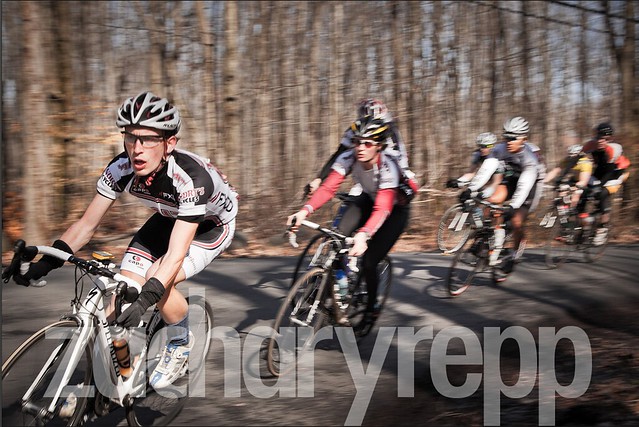
At the start of the third climb I was starting to get worried, since I knew my window for making a move was about to close. Luckily, the pace up the hill stayed high, and it was clear some people were starting to suffer. A Rutgers rider attacked halfway through the climb and the pace surged, a bit more than Laura could handle. As she dropped back from the front, she screamed “Zack!” and I made my move with a moderate seated sprint, followed by a few minutes of hard work up the hill. I bridged to the Rutgers rider, realized he was hurting more than he should, and bridged again to the Pitt rider at the top of the hill. I was a bit worried he’d already be exhausted from a solo lap, but he said he was feeling OK and willing to do work to make the break work. We took turns pulling for the rest of the third lap, but by the end of the lap it was clear he was suffering. He had dropped his bottle and had run out of sugar/water, so I gave him my last bottle of sports drink to try and get him through the end of the race , since we still had 15 miles left with the field chasing and no idea of how far back the pack was.
On the final climb, it was clear that the Pitt rider was too tired to match my threshold pace, so I kept the pace steady and spent the next 30 minutes riding alone; at every turn I looked over my shoulder expecting to see a surging peloton. I crossed the finish line alone, thoroughly exhausted, and slightly in shock (my first breakaway ever and my first win ever), with an unexpected 2:20 minutes on the main field.
Sebo and Matt stayed with the field while I was away, and covered every attack by other teams to try and catch the breakaway. Their blocking worked perfectly, and I’m told that at one point someone (UMD?) asked Sebo pointedly “are you going to do any work?”, to which his answer was “no”, of course. Matt led out Sebo for the final finish, and Sebo ended up with fourth place and Matt with 10th. Our strategy ended up working, and this was a perfect example of how much you can do with a strong team. Without Sebo and Matt controlling the group pace, there’s no way the breakaway would have ended up working.
The last event of the weekend was a hilly crit, with one non-technical turn, a small 80-ft hill followed by a sweeping descent and short flat bit (not much of a real crit, but it certainly suited me). Once again, we were pretty nervous about our chances of winning the race; I had never gotten a top-5 in a crit, can’t really sprint, and I assumed that anything I did would be immediately covered by the other riders after winning both events on the previous day. Our plan was basically the same as for the road race; Sebo would go for the first prime and keep the pace high, I would attack on the hill after the second prime, and if things failed we would give Sebo a lead-out for the win.
The plan worked perfectly; Sebo got his prime and when I made my move on the second one, two others tried to cover (a strong Dartmouth climber, and the same Pitt rider from the previous day). Only the Dartmouth rider managed to hold my wheel, and the two of us worked together for a couple of laps; he did some great work on the downhill/flat sections and we built up a lead of about 40 seconds. After a few laps he started to fade on the hill, and I took off solo for the next four laps, afraid that time lost on the hill would doom the effort. I finished on my own again, followed by the Dartmouth rider. Sebo blocked for most of the crit until he was sure that I was going to be OK on my own, and then broke off with a UMD rider, whom he beat in a sprint finish, taking third overall, with Matt in the points in the pack finish. As on Saturday, this was an amazing team effort, with a better outcome than any of us expected.
Combined with the huge success in the Men’s/Women’s A fields, Men’s C field, and the great work in the other fields, this weekend turned out far more exciting than I expected.
